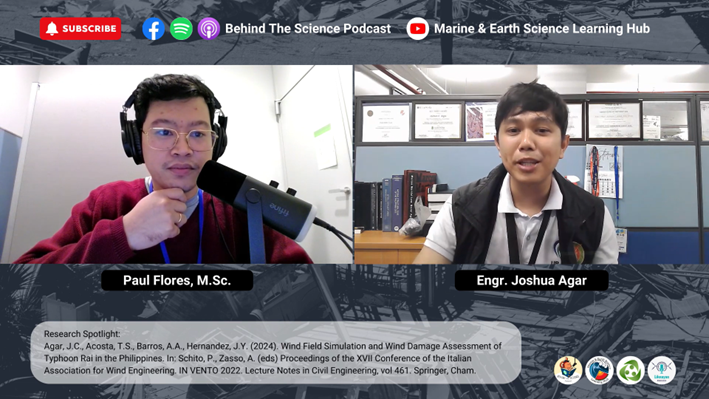Episode 49 of the Behind the Science Podcast features Engr. Joshua Agar, a wind engineering specialist who, along with his team, modelled the wind strength and surveyed the structural damage brought by Super Typhoon Odette (international name Rai) in 2021. His research, which became the primary focus of this episode, provided insights into understanding structural resilience against tropical cyclones and structural vulnerability in Cebu Province, one of the landfall points of ST Odette.
Engr. Agar discusses his team’s work entitled, “Wind Field Simulation and Wind Damage Assessment of Typhoon Rai in the Philippines,” which was notably the first study that modelled the effects of ST Odette, focusing on its effects within Cebu which had been a pilot site for a previous project of theirs that intended to enhance the vulnerability curves of different building types in the Philippines. Seeking to build on and validate the results of their previous study, their team conducted a field survey and assessed the extent of the building damage in order to relate the damage to wind strength.

Prior to his career as an educator and researcher in wind-related and structural hazards, Engr. Agar was a political science student in UP Diliman who intended to become a lawyer until, seeking to apply himself to a discipline with a more tangible approach, he changed majors and pursued civil engineering. It wasn’t until his thesis year that he discovered wind engineering, a civil engineering subspecialty that combines civil engineering, mechanical engineering, and meteorology, and discovered the appeal of a research profession. Engr. Agar traced back this interest prior to his college days, recalling his fascination with typhoons as he closely followed storm updates and forecasts.
Today, Engr. Agar works as an Assistant Professor at the UP Diliman Institute of Civil Engineering and Research Fellow at the UP Center for Air Research on Urban Environments. Aside from his work in the academe, he also plays billiards competitively and expresses that he finds joy in sharing insights and research work on social media, where a number of his posts have gone viral and sparked interest and debate among the public. Listen to this episode of The Behind the Science Podcast featuring Engr. Joshua Agar below:
Youtube: bit.ly/btspodcast-yt
Spotify: bit.ly/btspodcast-spotify
Facebook: https://bit.ly/btspodcast-fb
Research spotlight:
Agar, J.C., Acosta, T.S., Barros, A.A., Hernandez, J.Y. (2024). Wind Field Simulation and Wind Damage Assessment of Typhoon Rai in the Philippines. In: Schito, P., Zasso, A. (eds) Proceedings of the XVII Conference of the Italian Association for Wind Engineering. IN VENTO 2022. Lecture Notes in Civil Engineering, vol 461. Springer, Cham.
Do you want to nominate a scientist in the field of DRR and geosciences to be featured on the Behind the Science Podcast? Or, have you read an author’s publication whose behind-the-scenes story you are eager to hear about? Email us at upri.educ@up.edu.ph, and we will do our best to feature them on the BTS Podcast!
